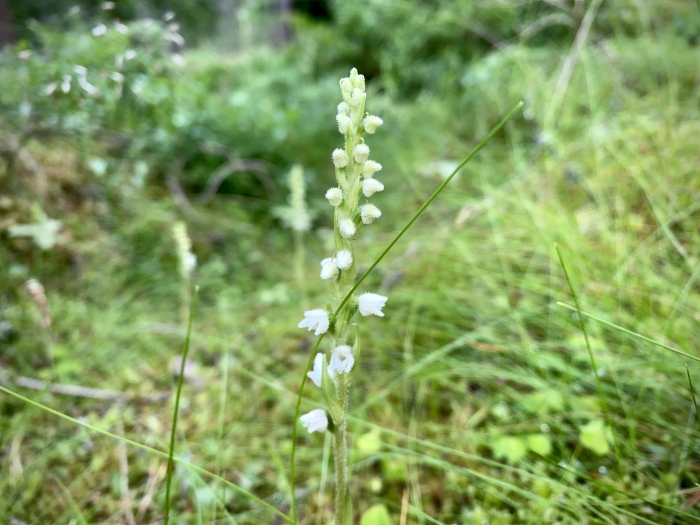Dwarf Rattlesnake Plantain
(Goodyera repens)
Dwarf Rattlesnake Plantain (Goodyera repens)
/
/

Andrew Melton
CC BY 4.0
Image By:
Andrew Melton
Recorded By:
Copyright:
CC BY 4.0
Copyright Notice:
Photo by: Andrew Melton | License Type: CC BY 4.0 | License URL: http://creativecommons.org/licenses/by/4.0/ | Rights Holder: Andrew Melton | Publisher: iNaturalist | Date Created: 2020-07-15T13:56:34Z |

























Estimated Native Range
Summary
Goodyera repens, commonly known as Creeping Lady’s-tresses in Europe and Dwarf Rattlesnake Plantain in North America, is a perennial herbaceous orchid native to coniferous and mixed woodlands, as well as to moist, shaded areas in bogs and along stream banks. It has a circumboreal distribution, being found in parts of Europe, Asia, and North America, including countries such as Russia, China, Germany, Poland, the UK, Canada, and the United States. The plant typically grows in mature forests, often those over 95 years old, and is sensitive to disturbances such as fire or logging. Goodyera repens reaches a height of 4-6 inches (10-15 cm) and features a rosette of variegated leaves with a distinctive white veining pattern that resembles a rattlesnake’s skin.
This orchid is valued for its ornamental foliage and the delicate beauty of its flowers. It blooms in the summer, producing slender stems with spiral-arranged, white flowers that twist to face the sun. The flowers are modest in size but can be quite showy when observed up close. In cultivation, Goodyera repens requires a cool, moist environment with dappled shade, mimicking its native woodland habitat. It prefers well-drained, humus-rich soil and consistent moisture, but it does not tolerate waterlogged conditions. Due to its symbiotic relationship with mycorrhizal fungi, which is essential for nutrient uptake, it can be challenging to cultivate outside of its natural setting. This orchid is mainly grown by enthusiasts in woodland gardens or specialized orchid collections. It is pollinated by bumblebees, and its presence can indicate a healthy, undisturbed ecosystem.CC BY-SA 4.0
This orchid is valued for its ornamental foliage and the delicate beauty of its flowers. It blooms in the summer, producing slender stems with spiral-arranged, white flowers that twist to face the sun. The flowers are modest in size but can be quite showy when observed up close. In cultivation, Goodyera repens requires a cool, moist environment with dappled shade, mimicking its native woodland habitat. It prefers well-drained, humus-rich soil and consistent moisture, but it does not tolerate waterlogged conditions. Due to its symbiotic relationship with mycorrhizal fungi, which is essential for nutrient uptake, it can be challenging to cultivate outside of its natural setting. This orchid is mainly grown by enthusiasts in woodland gardens or specialized orchid collections. It is pollinated by bumblebees, and its presence can indicate a healthy, undisturbed ecosystem.CC BY-SA 4.0
Plant Description
- Plant Type: Herb
- Height: 0.5-1 feet
- Width: 0.5-1 feet
- Growth Rate: Slow
- Flower Color: White
- Flowering Season: Summer, Fall
- Leaf Retention: Evergreen
Growth Requirements
- Sun: Part Shade, Full Shade
- Water: Medium
- Drainage: Medium
Common Uses
Bee Garden, Low Maintenance
Natural Habitat
Coniferous and mixed woodlands, as well as moist, shaded areas in bogs and along stream banks
Other Names
Common Names: Dwarf Rattlesnake Plantain, Lesser Rattlesnake Plantain
Scientific Names: , Goodyera repens, Elasmatium repens, Epipactis chinensis, Epipactis mairei, Epipactis ophioides, Epipactis ophioides, Epipactis repens, Epipactis repens, Epipactis repens var. ophioides
GBIF Accepted Name: